We might only notice whales when they appear in our world, but beyond the scopes of whale watchers, whales and dolphins live rich - and noisy - lives. In fact scientists are only just beginning to understand the importance of sound in the world of whales, and how much they rely on their ears to understand the world.
At the same time we’re starting to realise just how much noise humans make underwater, and the damaging effects on marine life. It’s time to seriously address the problem of acoustic pollution.
Incredible sense of hearing
Imagine humans couldn’t see further than half a block away, even on a good day. And instead of covering one quarter of the earth’s surface, our environment covered three-quarters.
Welcome to the world of cetaceans (whales and dolphins): 88 species of mammals that have evolved into specialised forms over the last 25 million years.
The vital sense that has allowed such diverse evolution is not sight, but hearing. Sound travels at approximately 1500m/sec through seawater (almost five times faster than in air). Cetaceans use sound to understand their environment with three-dimensional clarity, and to communicate over thousands of kilometres.
Whales have been communicating across ocean basins for millions of years – meanwhile humans have only been able to do so as recently as a century and a half ago following the invention of the telegraph.
Cetaceans can passively listen to the sound of cracking ice, or waves breaking on shorelines thousands of kilometres away to guide their migrations. They emit pulses of active sonar clicks to echolocate prey and identify environmental features at scales down to millimetres. A 200kHz series of clicks from a beaked whale can find objects as small as 50mm, from 100m away.
Cetaceans also use sound to communicate. Humpback whales sing, dolphins whistle and blue whales moan. But while we can understand the physics of the passive listening and echolocation, we are yet to crack the code of the whales’ rhythmic language.
Acoustic pollution
As our knowledge grows of how these complex aural systems operate, we are beginning to recognise the consequences of our own acoustic impact on the planet.
Human-generated noise in the ocean has increased dramatically in the past century due to the advent of mechanised ships. Large ships and their relatively slow-turning propellers can be heard, even with crude human-made underwater listening devices, for over 100km.
Tropical fish larvae are instinctively attracted to low frequency noise, such as that generated by waves breaking on coral reef; recent studies show that fish larvae are also attracted to shipping noise. Larval fish and invertebrates are drawn away from their usual habitats, upsetting their own development and the ecosystems that depend on them. Ultimately the populations of predators which feed on them will also be depleted.
We already manage airborne noise pollution in our cityscapes, through planning for airports, roadways and power generation. Logically, the next step in our environmental legislation may be to manage our human acoustic footprint in the ocean.
Why whales need quiet
Whales may also be suffering from acoustic overload. A recent study in Western Australia’s Exmouth Gulf, a calm water sanctuary for southward migrating humpback whales and newborn calves, shows that the mothers of these calves prefer to keep their young separated from other calves by 1.8km while resting and nursing. Separating the calves ensures adequate rest for both the calves and their mothers, and rest is important for female whales.
Young whales, like most young mammals, are easily stimulated, especially in noisy environments. Stimulation costs the calves energy, but specifically it costs the mother’s energy. Her blubber supply, used to fuel migration and calving, can only be replaced some 4000km away at feeding grounds in the Antarctic.
If her blubber supply is the limiting resource, and noise is a cost generator at a time when junior should be storing energy supply rather than burning it, then its easy to imagine why humpback whale mothers gravitate towards quiet, stimulus free areas.
The Great Barrier Reef may already be too noisy in some places to allow whales to rest. Identifying where the natural resting places are in relation to our own uses should become a priority if that population is to reach its full potential.
Currently managers are encouraged to direct shipping inside the Great Barrier Reef rather than sending it around the outside, where ships are susceptible to the swell from the open ocean and onshore winds.
With thousands of shipping movements along the eastern seaboard each year, and more promised, is it sensible to direct this increasing traffic problem inside the world’s greatest biological treasure? Not only is the risk of grounding and fuel spills an increasingly unmanageable risk, but our compelling and new understanding of the impacts of noise pollution on our fisheries and cetaceans should make the answer simple – plot a new course.

